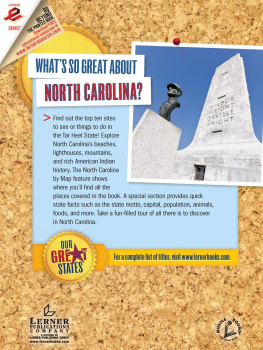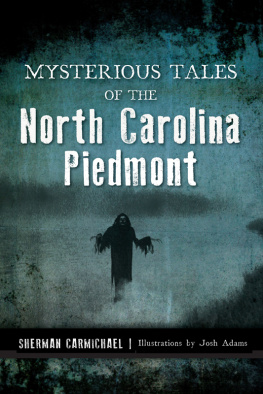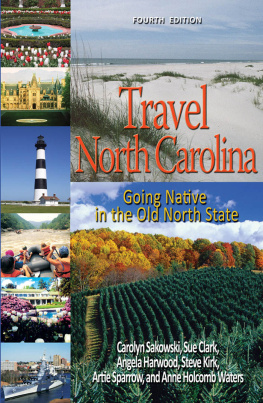The North Carolina Gazetteer
2010 THE UNIVERSITY OF NORTH CAROLINA PRESS
All rights reserved. Designed by Kimberly Bryant and set in Arnhem by Rebecca Evans. Manufactured in the United States of America. The paper in this book meets the guidelines for permanence and durability of the Committee on Production Guidelines for Book Longevity of the Council on Library Resources. The University of North Carolina Press has been a member of the Green Press Initiative since 2003.
Library of Congress Cataloging-in-Publication Data
Powell, William Stevens, 1919
The North Carolina gazetteer: a dictionary of Tar Heel places and their history /
William S. Powell and Michael Hill.2nd ed.
p. cm.
The classic reference updated for a new generationwith more than 20,000 entries.
Includes bibliographical references.
ISBN 978-0-8078-3399-5 (cloth: alk. paper)ISBN 978-0-8078-7138-6 (pbk.: alk. paper)
1. North CarolinaGazetteers. 2. Names, GeographicalNorth Carolina.
I. Hill, Michael R., 1954 II. Title.
F252.P6 2010
975.6dc22 2009045021
cloth 14 13 12 11 10 5 4 3 2 1
paper 14 13 12 11 10 5 4 3 2 1
For
my mother
and in memory of
my father,
who from summer to summer took
me on vacation trips from one
end of North Carolina to the other.
I cannot remember when I did not
know and love the coast, the
mountains, and many special places
in between.
William S. Powell, 1968
Preface to the Second Edition
It is remarkable to consider the number of place names that derive from the difficulties that North Carolinians had in crossing creeks. Pig Basket Creek in Nash County, for example. It seems that an early settler, headed home with a basket of newborn pigs, dropped them into the water as he tried to cross the creek, which was swollen by recent rains.
Then there are the place names with unusualoften wildly soderivations: Asey Hole, Bandana, Black Ankle, Calico Creek, Cat Square, Dixie, Easy Street, Enola, Haoe, Handy, Hanging Dog, Huggins Hell, Ivanhoe, Lawyers Spring, Naked Mountain, Observer, Oriental, Revolution, Rhodo, Shakerage, Tater Hill, Virgilina, Whynot.
Look a little further and you will find 12 Concords, 11 Gum Swamps, 10 Big Laurels, 9 Tarkilns, 8 Silvermines, 7 Frying Pans, 6 Vances, 5 Milksicks, 4 Whetstones, 3 Sengs (as in ginseng), 2 Kill Quicks, and 1and only 1Shit-Britches Creek. Add to that 149 Bears, 103 Beavers, 85 Chestnuts, 85 Horses, 68 Wolfs, 68 Grassys, 66 White Oaks, 51 Turkeys, 49 Saints, 46 Hogs, 38 Buffalos, 35 Little Creeks, 34 Forts, 30 Wildcats, 32 Rattlesnakes, 28 mentions of Sassafras, 22 Ravens, 14 Jumping Runs, and 13 Town Creeks.
We know all of this because of William S. Powell's work on The North Carolina Gazetteer. Published in 1968, the book set a new standard for guides to place names. It is the most consulted book in my office and in many offices and libraries. No other state has anything to approach it. Powell's Gazetteer is a classic, a work of use to historians, genealogists, librarians, journalists, creative writers, geographers, urban planners, armchair travelers, and anyone with an interest in the Old North State. In working on a revised edition, I did so with the knowledge that the book is a gem, and, aside from a new polish and a few new facets, it should remain largely intact. To my mind, the Gazetteer provides no greater service than to preserve the memory of places already gone or in danger of disappearing due to urban growth and developmentwhat might be called suburban swallowups.
Indeed, the question may arise about the need for this type of reference book in the Digital Age of the twenty-first century, when information is a few keystrokes away via Google Earth, MapQuest, WorldCat, and other Internet marvels. Global Positioning System (GPS) units are now inexpensive and widely used. I would argue that these new technologies and databases make the Gazetteer all the more valuable. New technologies can locate with precision the places we live, work, and play, but technology alone cannot tell their stories. With its focus not just on locating but on describing the origins and naming of North Carolina's cities, towns, crossroads communities, waterways, peaks, and other places and physical features, the Gazetteer is as valuable today as it was when first published more than forty years ago. And given the state's rapid growth over the last decades, there are many new readers who can learn from and enjoy the information contained herein.
In 2007 Professor Powell and editors at the University of North Carolina Press asked me to take on the responsibility of producing this revised edition. With 19,638 entries in the original edition, I commenced my search for additional entries. In the end, I added about 1,200. The work would involve updates of existing entries and a close examination of the criteria to determine which new entries would be logical fits. Some of these were obvious. Jordan Lake, for example, did not exist when the original edition was published but undoubtedly belonged in the Gazetteer. Most readers would join me in recognizing that, for the most part, we stopped making a significant number of new place names a long time ago. Some modern names do not belong in the book. This would include residential subdivisions, the kinds of communities that spell harbor with a u and town with an e.
This matter of list making, of course, did not begin with Professor Powell. Map-makers have been at work describing, depicting, and inventorying the landscape since the days of John White and the Roanoke colonies. A substantial number of Tar Heel place names from Chicamacomico to Nantahala have Native American origins. Successive waves of settlersthe Moravians to name just one groupassigned names to places. The Revolutionary War generation left the greatest imprint on place names, having the distinction of selecting most county names. Arnold Guyot, the Harvard scientist who came south to survey the North Carolina mountains in the 1850s, kept such a list in his notebooks along with altitudes. Today, Mount Guyot, named in his honor, stands in Haywood County and is duly recorded in the Gazetteer.
Professor Powell made wide use of maps in producing his original work. One that he did not consult is the 1901 Historical Map and Gazetteer of North Carolina, prepared by D. C. Mangum of Durham and issued by Rand McNally. It is the type of old wall map that once decorated classrooms, depots, and public buildings. For this project, the utility of the beautifully designed and richly detailed Mangum map derives from the year of its issue: 1901. The map was prepared during the heyday of small, unincorporated communities in North Carolina, after the rise of the railroads and the proliferation of post offices but, importantly, before the consolidation of post offices and the use of rural free delivery, which came about after 1915. Interested readers are invited to examine the Mangum map and other digitized maps at the North Carolina Maps project website (http://www.lib.unc.edu/dc/ncmaps/index.html).
In his preface, Professor Powell explained why he elected not to include most post offices. In short, it was because in many cases these were not true communities but rather a store, a gristmill, or just someone's house. Still, there was inconsistency with respect to post offices. For Warren County and Caswell County, every post office is included in the original edition. Mangum's map helped separate the wheat from the chaff among the 6,900 post offices that have operated in North Carolina over the years. From the Mangum map, I could detail the section of the county where the community was located. If it was on a creek or a railroad, I could determine that. Of course, it was silent with respect to name derivation. But with a list of place names in hand from the Mangum map, I then could turn to the four-volume guide to post offices issued by the North Carolina Postal History Society in 1997 to record the years of operation.
Next page




